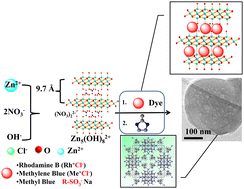Dye encapsulation and one-pot synthesis of microporous–mesoporous zeolitic imidazolate frameworks for CO2 sorption and adenosine triphosphate biosensing†
Abstract
One-pot co-precipitation of target molecules e.g. organic dyes and the synthesis of a crystal containing microporous–mesoporous regimes of zeolitic imidazolate frameworks-8 (ZIF-8) are reported. The synthesis method can be used for cationic (rhodamine B (RhB), methylene blue (MB)), and anionic (methyl blue (MeB)) dyes. The crystal growth of the ZIF-8 crystals takes place via an intermediate phase of zinc hydroxyl nitrate (Zn5(OH)8(NO3)2) nanosheets that enabled the adsorption of the target molecules i.e., RhB, MB, and MeB into their layers. The dye molecules play a role during crystal formation. The successful encapsulation of the dye molecules was proved via diffuse reflectance spectroscopy (DRS) and electrochemical measurements e.g., cyclic voltammetry (CV), linear sweep voltammetry (LSV), and electrochemical impedance spectroscopy (EIS). The materials were investigated for carbon dioxide (CO2) adsorption and adenosine triphosphate (ATP) biosensing. ZIF-8, RhB@ZIF-8, MB@ZIF-8, and MeB@ZIF-8 offered CO2 adsorption capacities of 0.80, 0.84, 0.85, and 0.53 mmol g−1, respectively. The encapsulated cationic molecules improved the adsorption performance compared to anionic molecules inside the crystal. The materials were also tested as a fluorescent probe for ATP biosensing. The simple synthesis procedure offered new materials with tunable surface properties and the potential for multi-functional applications.

- This article is part of the themed collection: Nordic Collection


 Please wait while we load your content...
Please wait while we load your content...